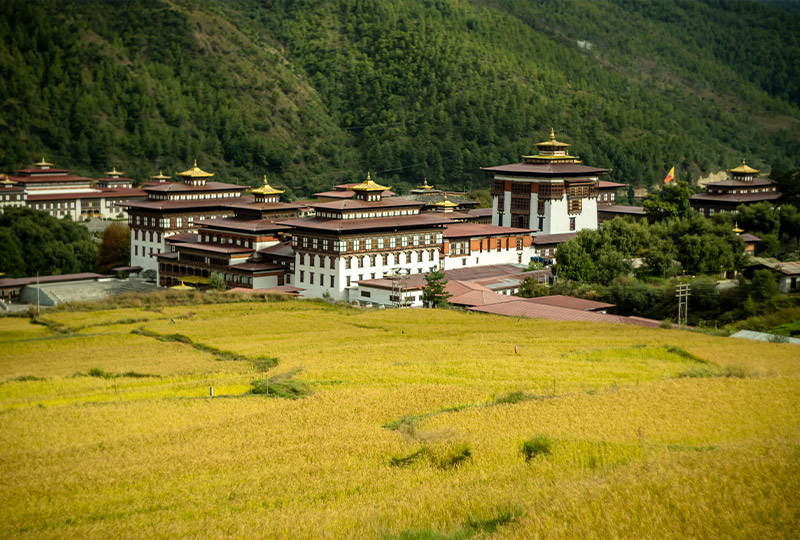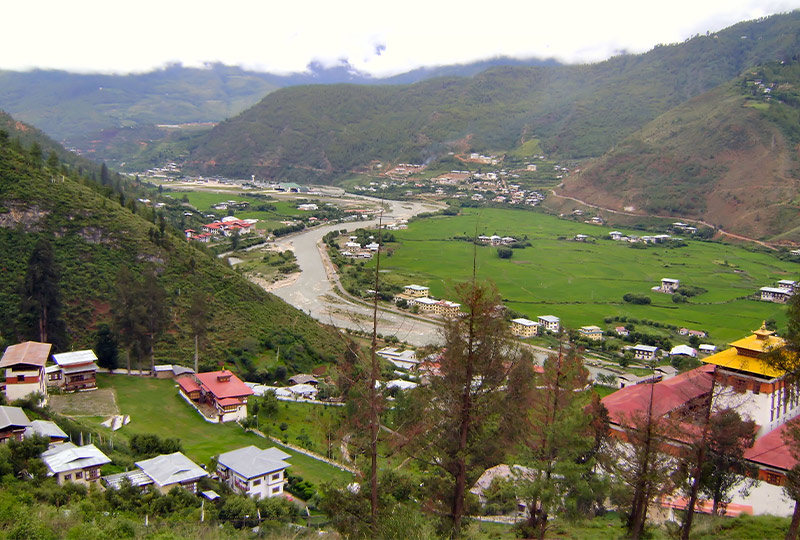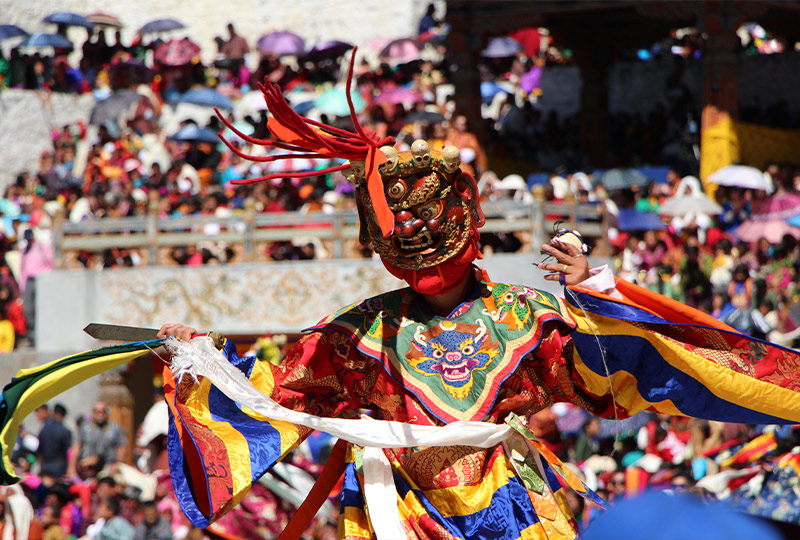In the first place, Bhutan has four major seasons. Secondly, there are two best seasons to visit Bhutan. And yes, because of its location, the Dragon Kingdom has its own climate features. So, the best time to go to Bhutan will depend on your personal choice. Nevertheless, the weather of the mountain nation has its distinctive regional features. For this purpose, we will explain about each climate briefly to add it to your knowledge.
The western part of the country indeed receives heavier rainfall. Likewise, the southern parts have sultry, humid summer and cool winter. Since Bhutan lies next to Bangladesh, it is sometimes affected by the remains of the tropical cyclones. As a result, this will affect the weather conditions of the whole country. Hence, you will have a deep feeling about this magical weather and climate change in the Druk-Yul.

Weather & Climate of Bhutan
Of course, the weather conditions in Bhutan are majorly influenced by the altitude. And more surprisingly, they are similar to that of arctic, frozen and frosty. The mountain peaks are constantly covered with snow and the lower parts are still cool even during summers.
While in the southern parts, the weather is hot and humid in summer and cool during winter. Similarly, the central parts of the country have temperate and deciduous forests where the climate is more seasonal with warm summers and cool, dry winters.

Major Seasons in Bhutan
Basically, Bhutan has 4 major seasons: Spring, Summer, Fall, and Winter. The monsoon season comes after the onset of summer and ends before the falls (also called autumn). March to May, indeed, is springtime. Likewise, summer is between the months of June and August. The fall or autumn are months from September to November, while winter is from December through February.
The following tabular representation will give you a clear idea about the weather conditions of Bhutan throughout the year:
| Season | Month | Features | Ratings |
| Spring | Mar – May | – Undoubtedly, the best time to visit Bhutan – The daily temperature averages up to 17oC (63oF) – Incredible hikes in the tranquil trails | Best |
| Summer | Jun – Aug | – Wet weather almost throughout Bhutan – Marks the arrival of monsoon – The average daytime temperature is 24oC (75oF) | Not recommended |
| Fall (Autumn) | Oct – Dec | – Ideal time to visit Bhutan due to its mild climate – Temperature during the day is 22oC (71oF) – Visibility of the mountain views are sparkling clear | Best |
| Winter | Dec – Feb | – The coldest time of the year – The temperature reaches 10oC (50oF) – Icy winds of the northeast monsoon make the climate colder | Average |
1. Spring season (March – May)
Spring can get cloudier than other months comparatively. Moreover, the wildlife and flowers are at their most vivid. In addition, the magnificent rhododendrons, magnolias and other wildflowers can be seen blooming. The birdlife is surprisingly abundant. And, most festivals occur during this season, so you might get a chance to witness one of the Bhutan’s popular festivals. Therefore, spring is perhaps the best time to visit Bhutan!
2. Summer/Monsoon (June – August)
It is good to consider visiting Bhutan during summer if you wish to steer clear of the higher tariff and the winter cold. Because, evidently the season sees a lower number of tourists in Bhutan. One festival to participate during June would be Nimalung Tsechu. But, we do not recommend traveling to Bhutan in summer! Roads could get blocked due to landslides.
3. Fall or Autumn season (September – November)
In fact, these months are less wet and skies are clear, the air is fresh and perfect for hiking in the secluded trails. So, that makes it an ideal time to visit Bhutan. The beginning of fall may see showers in some parts of the country while the northern part could already experience some snowfall at higher elevations. Fall is also a good time to visit Bhutan! After all, if you are lucky, you may get to witness Thimphu Tsechu, one of Bhutan’s popular festivals this season.
4. Winter (December – February)
As a matter of fact, winter would be the time to visit Bhutan if you wish to avoid travelers’ crowd and catch up on the black-necked cranes. However, winters in Bhutan are quite cold, but the skies are usually clear, providing stunning views and great opportunity to photographers. During winter, the Trongsa Tshechu festival takes place in Trongsa Dzong. Thus, we recommend winter season for traveling to those travelers who can endure the chilly weather conditions.
Region-wise weather of Bhutan
Since Bhutan has a diverse range of altitude, let us quickly look at how the weather is at various regions.

1. Southern Regions
Chiefly, the southern regions of the country comprise the plains with subtropical weather conditions. As a result, these regions experience mild winters with cold nights. Spring time is hot and thunderstorms are frequent during this time. It is a fact that during monsoon, it rains heavily and sometimes it becomes torrential. For instance, the average temperatures of the southern region of Bhutan can be clearly understood below:
| Months | Min ºF | Max ºF | Travel Rating |
| Jan | 32 | 73.4 | Average |
| Feb | 53.6 | 77 | Average |
| Mar | 59 | 84.2 | Best |
| Apr | 68 | 89.6 | Best |
| May | 71.6 | 89.6 | Good |
| Jun | 75.2 | 87.8 | Bad |
| Jul | 77 | 87.8 | Bad |
| Aug | 77 | 87.8 | Bad |
| Sep | 75.2 | 87.8 | Good |
| Oct | 69.8 | 86 | Best |
| Nov | 59 | 80.6 | Best |
| Dec | 51.8 | 77 | Average |
2. Hilly Regions
Comparatively, the climate is gradually milder, with moderately cold, dry winters and warm, rainy summers in the hilly regions, up to the elevation of 1,524m (5,000ft.). But, in some interior valleys, summer rains are moderately lesser with monsoon rains on the southern side. Summer months, however, are quite hot irrespective of the altitude. For instance, the average temperatures of the hilly areas of Bhutan can be clearly understood below:
| Months | Min ºF | Max ºF | Travel Rating |
| Jan | 41 | 62.6 | Average |
| Feb | 46.4 | 66.2 | Average |
| Mar | 51.8 | 71.6 | Good |
| Apr | 57.2 | 77 | Best |
| May | 62.6 | 80.6 | Best |
| Jun | 68 | 84.2 | Average |
| Jul | 68 | 82.4 | Bad |
| Aug | 68 | 82.4 | Bad |
| Sep | 68 | 80.6 | Good |
| Oct | 60.8 | 78.8 | Best |
| Nov | 50 | 73.4 | Best |
| Dec | 42.8 | 68 | Average |
3. High-Altitude Regions
The average temperatures during summer, especially at higher altitudes above 1,981(6,500ft.), range from 5-20ºC / (41- 68ºF). Obviously, winters will be cold, and nighttime will experience below-freezing weather in these areas. Winters are mostly sunny, while snowfall can be an amusing revelation. For example, the average temperatures of the high-altitude areas in Bhutan can be clearly understood below:
| Months | Min ºF | Max ºF | Travel Rating |
| Jan | 26.6 | 53.6 | Average |
| Feb | 33.8 | 57.2 | Average |
| Mar | 39 | 60.8 | Good |
| Apr | 44.6 | 68 | Best |
| May | 55.4 | 73.4 | Best |
| Jun | 59 | 75.2 | Average |
| Jul | 59 | 77 | Bad |
| Aug | 60.8 | 77 | Bad |
| Sep | 59 | 73.4 | Good |
| Oct | 50 | 71.6 | Good |
| Nov | 41 | 64.4 | Good |
| Dec | 30.2 | 59 | Average |
Bhutan is extensively far away from sea, so there are direct impacts of the tropical cyclones. However, since it borders with Bangladesh, the after-effects of cyclones hitting Bangladesh can be at certain parts of Bhutan as well. As a result, these impacts may cause heavy rainfalls or sometimes snowfall in the higher altitudes.
Subsequently, taking in account all the weather factors, we can deduce that Bhutan is a year-round destination. However, the activities you wish to do in the country strictly defines your best time to visit Bhutan.
Why should I visit Bhutan?
One of the significantly major reasons why tourists visit Bhutan is its unique culture. Earlier in 2018, the nation was voted number one from over 100 sustainable destinations in the ITB awards held in Berlin, Germany. From amongst a long list of things to do in Bhutan, we highly recommend the following activities while actually touring this magnificent country:

1. Trekking & Hiking
Some of the major things you could do when you plan to visit Bhutan are Trekking, hiking or any adventurous activities. In fact, there are several trekking trails and local hiking opportunities, including a hike to the Tiger’s Nest. Nonetheless, hiking is one of the best ways to experience the culture of a country.
2. Cultural & Historical Tours
In the first place, with countless touristic spots to tour around, there are ample opportunities for cultural and historical tours in Bhutan. In fact, you may even experience a religious tour in the country. These tours, in fact, are ways to interact directly with the ethnic communities of your tour destination.
3. Festivals and Celebrations
HUGE indeed! Bhutan indeed has huge festivals. Regardless the festival, each one of them is celebrated with great fervor. To witness some of the vibrant festivals and celebrations, you can also plan your Bhutan tour coinciding with one of those festivals.
4. Bhutanese Cuisine
So, do you expect that Bhutanese food will leave you dumbfound? Surprisingly, most food items are non-vegetarian and comprises a lot of dairy products. However, the popular butter tea with salt is something you should not miss to try. Basically, most food items incorporate meat, chilly, spice, and cheese. Not to worry, there are vegetarian foods such as Eue Chum (Bhutanese Red Rice), and Hoentoe buckwheat dumplings including Ara, the fermented alcoholic drink made from rice.
5. Other adventure activities
Undoubtedly, there is abundant adventure for thrill-seekers. Because you get to enjoy outdoor activities like mountain biking, river rafting, kayaking, snow-mountain trekking, and wildlife safaris. But the best part is that you get to do it in the mountainous region with an amusing wintry climate, hills, and mountainous landscape.
6. Bhutanese Arts & Crafts
Each piece of art and craft in Bhutan indeed, denotes a spiritual experience for the locals. In fact, they take great pride in their culture, heritage, rituals, traditions, and festivals. Especially, skilled people who created the arts and crafts have been preserving such great traditional arts for several centuries. So, this is one of the reasons why you must visit Bhutan.
7. Less Crowds
Besides peak tourist seasons, there will be less crowds in the major tourist hubs. Likewise, it is the same even in the hiking trails. So, if you are seeking for a discreet place to meditate and evade the huge crowds, you can visit this time during anytime of the year.
“The weather of Bhutan especially fluctuates radically – it all depends on the elevation”
When should I visit Bhutan?
In the first place, if you’re an adventurer besides doing trekking, the best time to visit Bhutan would be October to December. However, for nature lovers and historical tourists, you can plan your holiday to Bhutan in springtime.
If you only wish to do trekking or hiking in Bhutan, then perhaps you should plan your trip between March to May. And, if you are seeking for lesser crowds during off-seasons, summer or monsoon will be the perfect time. Ultimately, if you wish to participate in one of those vibrant festivals of Bhutan, you need to plan accordingly as there is no fixed season for your participation. The country indeed, has festivals almost throughout the year!






